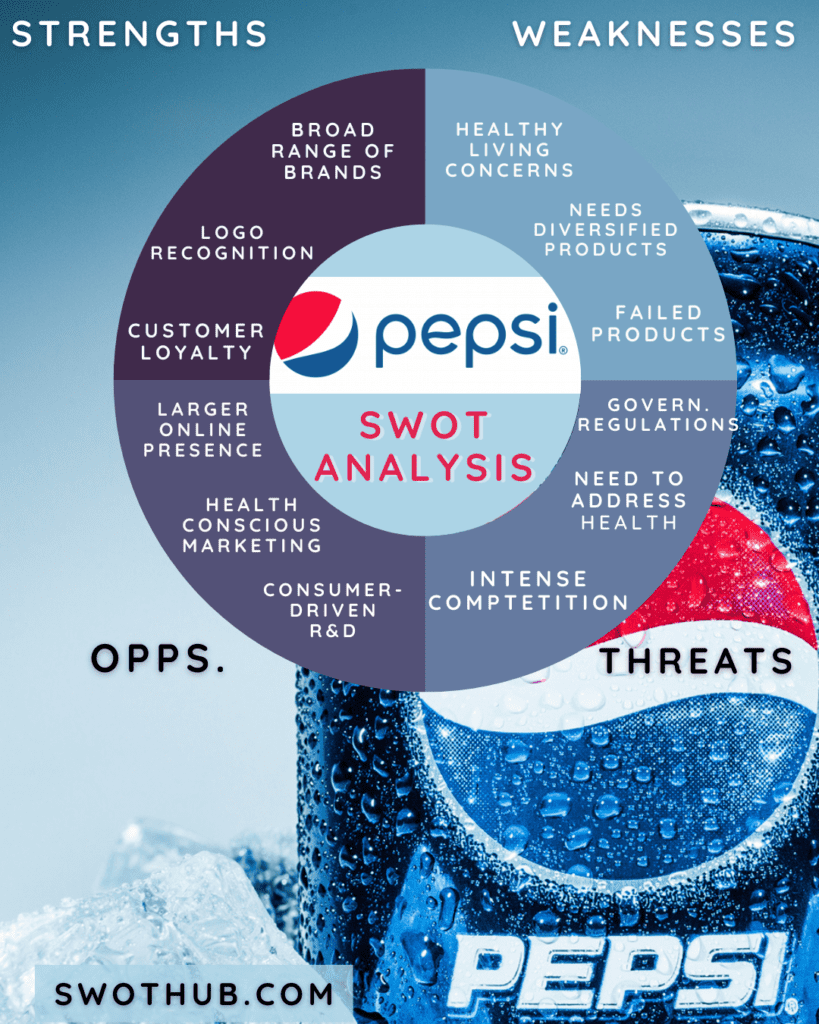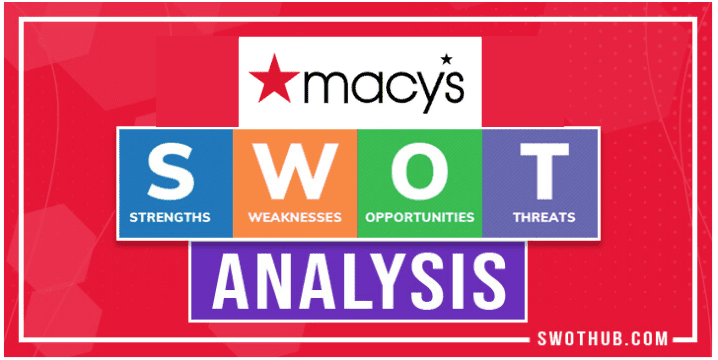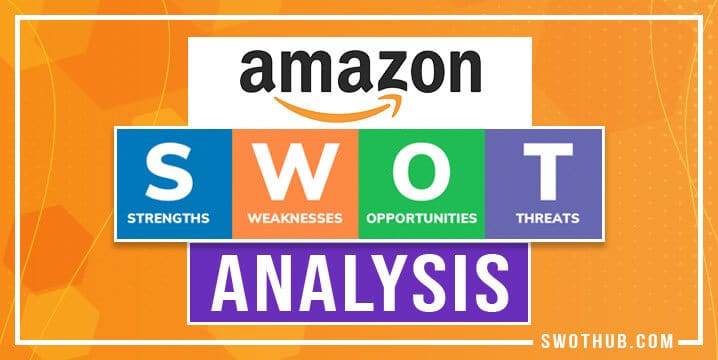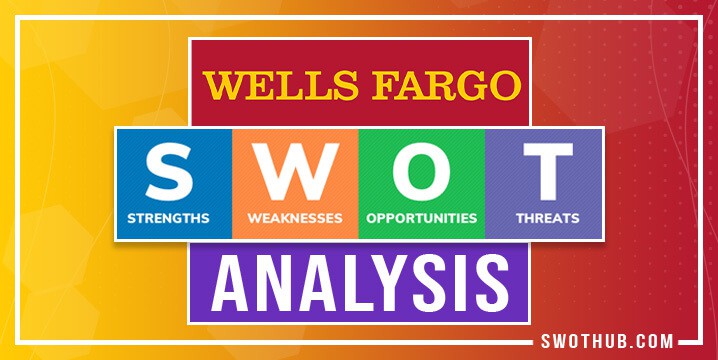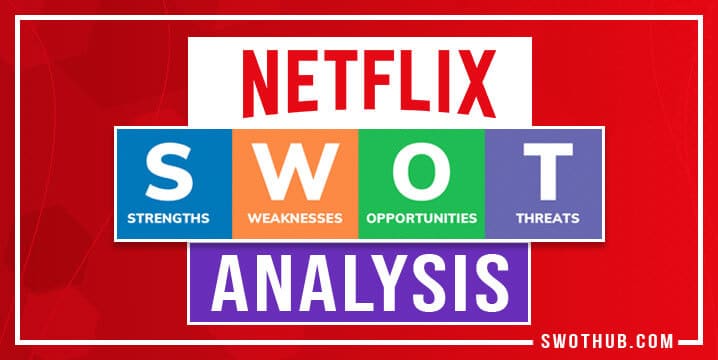The “Cola Wars” of the late 1970s to the mid-1980s had the world wondering, who’s better Coca-Cola or Pepsi? This PepsiCo SWOT analysis will highlight how this beverage war snowballed into one of the largest beverage AND food brands in the world. See who are PepsiCo competitors are and why they have a long way to go to catch up to the PepsiCo mammoth of the food industry.
Table of Contents
PepsiCo Strengths and Brief History
PepsiCo is the second largest food and beverage company, trailing only Nestlé. PepsiCo’s products include well-known food and beverage brands such as Pepsi, Gatorade, Frito-Lay, Quaker Oats, Rockstar Energy, and Muscle Milk. The current company was formed in 1965 by the merger of the Pepsi-Cola Company and Frito-Lay Inc., and it has grown steadily since then.
With operations in more than 200 countries, PepsiCo Inc. (PEP) is a multinational food and beverage company. PepsiCo’s food products include chips, flavored snacks, cereals, rice, pasta, and dairy-based products. Carbonated soft drinks, juices, ready-to-drink tea and coffee, sports drinks, and bottled water are among the beverages offered by the company. The company, headquartered in Purchase, New York, employs approximately 274,000 people worldwide.
PepsiCo Company – At A Glance
| Company’s Name | PepsiCo, Inc. |
| Company’s Former Names | Pepsi Cola |
| CEO | Ramon Laguarta |
| Company Type | Public |
| Year Founded | 1898 |
| Number of Employees | 267,000 (2019) (approximately) |
| Annual Revenue | US$ 67.16 billion (2019) |
| Founder | Caleb Bradham |
| Area Served | Worldwide |
| Headquarters | Harrison, New York, US |
| Operating Income | US$ 10.29 billion (2019) |
PepsiCo Competitive Advantage and the PepsiCo History
PepsiCo SWOT Analysis
SWOT stands for the organizational strengths, weaknesses, opportunities, and threats. A tactical tool known as SWOT analysis helps businesses examine both internal and external factors that affect their bottom line.
By taking PepsiCo’s strengths, weaknesses of PepsiCo threats of PepsiCo as well as opportunities of PepsiCo into account, we may better gain in-depth knowledge about PepsiCo’s company. Let us take a look at PepsiCo’s SWOT analysis framework to better understand its competitive position and potential for future growth.
PepsiCo SWOT Analysis Strengths
The areas where a company excels above average or in a manner that distinguishes it from its rivals are considered to be its strengths. The PepsiCo strengths are outlined in this PepsiCo SWOT analysis.
Broad Range of Brands: The business offers a broad portfolio of 100 brands. Moreover, PepsiCo has a broad range of brands in its portfolio. It draws a lot of clients their way.
Power of One Technique: PepsiCo is a stronger and more diverse company since it sells “Food & Snacks” (Frito Lays, Cheetos, Doritos, Kurkure) and “Beverages” (Pepsi, Gatorade, Tropicana) under one brand. 54% of its revenue came from the food industry, and 46% from the beverage industry.
Customer Loyalty: PepsiCo’s clientele is incredibly devoted. All of its soft drinks fall under the beverage category, and because of this, consumers do not favor switching brands. When it comes to the bottled water and juice categories, they have developed into a very powerful brand. With brands like Doritos, Lay’s, Funyuns, Uncle Chips, Cheetos, Tostitos, and Walkers operating under it, Frito-Lay has been one of the most popular brands in the world.
Brand Recognized Logo: PepsiCo has successfully created strong brand awareness. One of the icons that are well-known throughout the entire world is the PepsiCo logo. A solid customer base was also beneficial to them.
Distribution network: PepsiCo has one of the best networks in the world for making products available at various points in the supply chain. In addition, they have very effective linked reverse logistics.
PepsiCo SWOT Analysis Weaknesses
Weaknesses of a company are those that limit its potential, make it less competitive, and prevent it from achieving its goals. In this section of the PepsiCo SWOT analysis, we’ll look at PepsiCo’s strengths before moving on to some of PepsiCo’s weaknesses.
Dependency: Over reliance on carbonated soft drinks and packaged goods reduces a company’s ability to adapt in the event of market unrest. PepsiCo made the decision to ignore the advice of the wise men and put all of its eggs in the food and beverage basket. To reduce the risk of a total loss, the company should diversify.
Health concerns: PepsiCo primarily manufactures carbonated beverages. Due to rising health concerns, customers are more interested in non-carbonated beverages that utilize fewer sweeteners in their offerings. Several healthy food options are being introduced by rival brands.
Failed Products: PepsiCo has produced a number of unsuccessful goods, including “Crystal Pepsi,” which have damaged the company’s reputation and left room for its rivals to expand.
U.S.A Focused: The fact that PepsiCo might have a smaller geographic footprint than some of its rivals is another area of weakness. Although the company is well-established in the United States and other important markets, some emerging markets where some of its rivals are more well-established may not be as advantageous for it.
Adequate sponsorship concepts: PepsiCo offers sponsorships as well. But, if they are promoted by the wrong celebrity, the consequences could land the company in trouble. Customers are loud on social media, particularly when they disagree with or don’t like a celebrity.
PepsiCo SWOT AnalysisOpportunities
PepsiCo Company exists in a World full of opportunities. The following portion of the PepsiCo SWOT analysis will examine some of the PepsiCo opportunities:
Product diversification: The ability to grow a firm is made easier for a company with diversified product lines. PepsiCo has a wide range of businesses. They may therefore more easily prepare for future diversification that will result in their expansion.
Wide Operations: PepsiCo may strive to grow its business in the developing sector. Many customers conduct their online buying through digital channels. It’s possible that PepsiCo has a dedicated online storefront.
Customer satisfaction: Efforts to meet the demands of customers who are health-conscious. PepsiCo has increased its focus on lowering the amounts of added sugar, salt, and fat in 75% of its food products by 2025 to less than 100 calories per less than 1.1 grams of saturated fat per 100 calories, 12 ounces, and 1.3 milligrams of sodium per calorie.
Boost Consumer-Driven R&D: The secret to success is adapting to market developments. PepsiCo has the financial capacity to invest more in production, R&D, and go-to-market capabilities in order to gain a competitive edge in the rapidly evolving retail and consumer markets.
PepsiCo SWOT AnalysisThreats
Threats pose a risk to every company’s stability and profitability. This article on the PepsiCo SWOT analysis will address some of the threats that are important to examine and explore the Pepsico competition.
Government Rules and Regulations: Recently, governments have enacted more pro-health legislation in an effort to lower the number of illnesses and disorders linked to unhealthy and junk food. Given that PepsiCo’s product line consists primarily of harmful soft drinks and snacks, the trend’s escalation could threaten its profitability, sustainability, and possibly its ability to continue operating.
Economic crises: PepsiCo may experience a decline in sales as a result of a cash shortage. Additional factors like inflation and the recession may also have an effect on the company’s revenues.
Growing Health Consciousness: Given that the majority of PepsiCo’s soft drinks and snacks are regarded as being harmful, it follows that the corporation is at risk (Cannibalism) from growing health consciousness in consumer markets.
Negative Public Perception: In a Pepsico SWOT analysis, due to worries about the health effects of its products and the environmental impact of its operations, PepsiCo has also encountered a poor public image. The business has come under fire for using unsustainable packaging materials and fueling the obesity epidemic. PepsiCo has also received criticism for its marketing initiatives, including the contentious Kendall Jenner advertisement that was charged with trivializing social justice movements.
Intense competition: Coca-Cola, Nestlé, Dr. Peppers, Unilever, and other companies pose a serious challenge to PepsiCo’s profitability and market dominance. Due to the rising cost of retaining clients through advertising, promotions, and discounts, the competition also poses a danger to long-term sustainability and profitability.
PepsiCo Competitors and PepsiCo Competitive Advantage
Coca-Cola and Dr. Pepper Snapple are the two biggest PepsiCo Competitors for beverages; other smaller PepsiCo competitors exist but are insignificant in comparison to these two major competitors. Nonetheless, Coca-Cola is by far the biggest rival due to its enormous asset base, supplier and distribution networks, product portfolio, innovativeness, and worldwide product popularity which is highly comparable to Pepsi’s. In actuality, the operations of these two multinational corporations define the worldwide soft drink business.
PepsiCo SWOT Analysis Conclusion
PepsiCo needs to plan its business expansion more carefully, according to PepsiCo’s SWOT analysis. Every so often, new companies come into the market, and those already there try their best to adapt to the environment of the market and the shifting preferences of customers.
One of PepsiCo’s key advantages is its powerful brand recognition and supply chain infrastructure. The business ought to pay attention to its flaws, such as its unsuccessful products and new health risks. The implication is that PepsiCo excels at a variety of things and should keep doing them in the future. PepsiCo can, however, still make improvements in a number of other areas in the future. For the business, consider the following suggestions:
PepsiCo SWOT Analysis – Recommendations for a Growing Future Business
- PepsiCo must make an effort to introduce new, healthier products. They might introduce a new selection of non-carbonated beverages with lower calorie counts and no negative effects on diabetes patients.
- PepsiCo should diversify to reduce exposure to market risk.
- To attract more customers, PepsiCo needs to improve its marketing plans and initiatives by keeping PepsiCo competition in mind.
Looking for more food industry SWOT analyses? Take a look at Dunkin Donuts and Starbucks!


